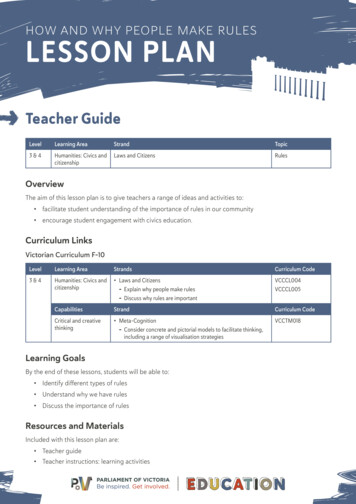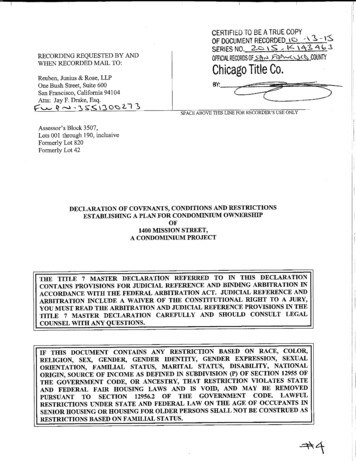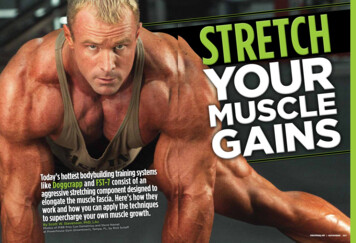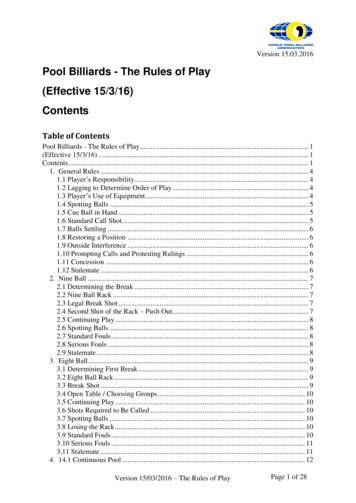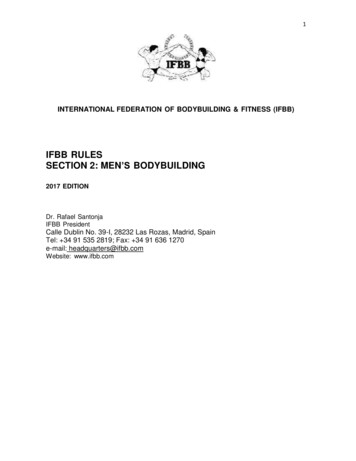
Transcription
1INTERNATIONAL FEDERATION OF BODYBUILDING & FITNESS (IFBB)IFBB RULESSECTION 2: MEN’S BODYBUILDING2017 EDITIONDr. Rafael SantonjaIFBB PresidentCalle Dublin No. 39-I, 28232 Las Rozas, Madrid, SpainTel: 34 91 535 2819; Fax: 34 91 636 1270e-mail: headquarters@ifbb.comWebsite: www.ifbb.com
2SECTION 2: MEN’S BODYBUILDINGArticle 1: IntroductionArticle 2: Responsibilities of Organizers to Athletes and DelegatesArticle 3: CategoriesArticle 4: RoundsArticle 5: Prejudging: Elimination RoundArticle 6: Prejudging: Posing Attire for All RoundsArticle 7: Prejudging: Assessing and Scoring of the Elimination RoundArticle 8: Prejudging: Presentation of Round 1 (Comparisons in Mandatory Poses)Article 9: Prejudging: Scoring of Round 1Article 10: Assessing of the Elimination Round, Round 1 and Round 2(Comparisons in Mandatory Poses)Article 11: FinalsArticle 12: Finals: Presentation of Round 2 (Mandatory Poses and Posedown)Article 13: Finals: Scoring of Round 2Article 14: Finals: Assessing of Round 2Article 15: Finals: Presentation of Round 3 (Posing Routines)Article 16: Finals: Scoring of Round 3Article 17: Finals: Assessing of Round 3Article 18: Finals: The Awarding CeremonyArticle 19: Finals: Overall Category and AwardArticle 20: Finals: Teams Classification Results and AwardsAppendix 1: Detailed Description of the Seven Mandatory PosesAppendix 2: Pictures of the Seven Mandatory Poses.3345566788999101010111111121213
3Article 1 – IntroductionMen’s Bodybuilding was officially recognized as a sport discipline in the modern versionby the 1970 IFBB International Congress in Belgrade, Yugoslavia. Women’s Bodybuildingwas officially recognized as a sport discipline by the 1982 IFBB International Congress inBrugge, Belgium, and was cancelled by the 2013 IFBB International Congress inMarrakesh, Morocco, being replaced by Women’s Physique division.1.1 General:The IFBB Rules for Men’s Bodybuilding consist of regulations, policies, directives anddecisions intended to guide the IFBB and its Members in the administration of the sport ofMen’s Bodybuilding.1.2 Rules:Certain administrative and technical rules that appear in Section 1: General Rules are thesame for Men’s Bodybuilding and therefore, are not repeated in this section.Article 2 – Responsibilities of Organizers to Athletes and Delegates2.1 ResponsibilitiesThe Organizer of a World Championships will undertake to cover the cost of doubleoccupancy accommodations and meals (breakfast, lunch and dinner) for athletes anddelegates as follows:1. World Bodybuilding Championships and IFBB International Congress (included Men’sBodybuilding, Men’s Classic Bodybuilding, Men’s Games Classic Bodybuilding Men’sPhysique, Muscular Men’s Physique):For five days (four nights) according to the following scale:a. Three or more competitors - Two delegatesb. One or two competitors - One delegateNote 1: The maximum allowable number of A-team competitors per NationalFederation may not exceed the number of categories open at these Championships,with a maximum of two competitors allowed to compete in any one category.Note 2: The maximum allowable number of A-team competitors per National Federationin any one discipline may not exceed the number of categories in that discipline.Note 3: A maximum of twenty competitors are permitted in the A-team (seven malebodybuilders, five male classic bodybuilders, two male games classic bodybuilders,six men’s physique athletes) and will be accepted per National Federation with amaximum of two competitors allowed to compete in any one category.Note 4: Each National Federation may enter a B-team. The maximum allowablenumber of competitors in the B-team shall not exceed those in the A-team. Detailedinformation regarding the A-Team and B-Team competitors is available in Section 1:General Rules, Article 9.3.Note 5: Delegates without athletes will have to pay for the Full Package Special Rate.Note 6: Upon agreement between the IFBB and the Organizer, one additional categorymay be opened for competition.2. In Senior Men’s Bodybuilding, each National Federation may enter:a. An A-team of up to a maximum of seven competitors, with a maximum of twocompetitors allowed to compete in any one category.b. A B-team of up to a maximum of seven competitors, with a maximum of twocompetitors allowed to compete in any one category.
43. World Juniors and Masters Bodybuilding and Fitness Championships:For four days (three nights) according to the following scale:a. Three or more competitors - Two delegatesb. One or two competitors - One delegateNote 1: The maximum allowable number of A-team competitors per NationalFederation may not exceed the number of categories open at these Championships,with a maximum of two competitors allowed to compete in any one category.Note 2: A maximum allowable number of A-team competitors per National Federation inany one discipline may not exceed the number of categories in that discipline.Note 3: A maximum of thirty six competitors in A-team (two female junior fitness, onemale junior fitness, one female junior bodyfitness, three female junior bikini fitness, twomale junior bodybuilders, one male junior classic bodybuilder, three male juniorphysique, twelve male master bodybuilders, three male master classic bodybuilders,three male master physique, two female master bodyfitness, two female master bikinifitness, one female master physique) will be accepted per National Federation with amaximum of two competitors allowed to compete in any one category.Note 4: Each National Federation may enter a B-team. The maximum allowablenumber of competitors in the B-team shall not exceed those in the A-team, except forthe masters categories, where the number of B-team competitors is unlimited. Detailedinformation regarding the A-Team and B-Team competitors is available in Section 1:General Rules, Article 9.3.Note 5: Delegates without athletes will have to pay for the Full Package Special Rate.Note 6: Upon agreement between the IFBB and the Organizer, additional categoriesmay be opened for competition.4. In Junior Men’s Bodybuilding (age 16-23 years), each National Federation may enter:a. An A-team of up to a maximum of two competitors.b. A B-team of up to a maximum of two competitors.5. In Master Men’s Bodybuilding (age over 40 years), each National Federation may enteran A-team of up to a maximum of twelve competitors.The number of B-team competitors is unlimited.Article 3 – Categories3.1 Categories:Bodybuilding competition at the World Championships is open in the following sevencategories:a. Bantamweight:b. Lightweight:c. Welterweight:d. Middleweight:e. Light-Heavyweight:f. Heavyweight:g. Super-Heavyweight:Up to and incl.Up to and incl.Up to and incl.Up to and incl.Up to and incl.Up to and incl.Over 100 kg65 kg*70 kg75 kg80 kg90 kg100 kg*- Only when held in Asia or South America.Note 1: Upon agreement between the IFBB and the Organizer, one additional categorymay be opened for competition.3.2 There are two categories in junior men’s world-level bodybuilding competition,
5currently as follows:- 16 to 23 years of age inclusive:a. Lightweight:Up to and incl. 75 kgb. Heavyweight:Over 75 kg3.3 There are twelve categories in master men’s world-level bodybuilding competition,currently as follows:- 40 to 44 years of age inclusive:a. Lightweight:Up to and incl. 70 kgb. Middleweight:Up to and incl. 80 kgc. Light-Heavyweight:Up to and incl. 90 kgb. Heavyweight:Over 90 kg- 45 to 49 years of age inclusive:d. Lightweight:Up to and incl. 70 kge. Middleweight:Up to and incl. 80 kgf. Light-Heavyweight:Up to and incl. 90 kgb. Heavyweight:Over 90 kg- 50 to 54 years of age inclusive:a. Middleweight:Up to and incl. 80 kgb. Heavyweight:Over 80 kg- 55 years of age and over:a. Middleweight:Up to and incl. 75 kgb. Heavyweight:Over 75 kg3.4 A category can only be run if there are not less than 6 athletes in this category. If lessthan 6 athletes, categories will be combined and run as one open class, if possible.Article 4 – Rounds4.1 Rounds:Men’s Bodybuilding will consist of the following four rounds:1. Prejudging: Elimination Round (Four Mandatory Poses)2. Prejudging: Round 1 (Four Mandatory Poses and Comparisons of Seven MandatoryPoses)3. Finals: Round 2 (Seven Mandatory Poses and Posedown)4. Finals: Round 3 (Free Posing Routines – 60 sec.)Article 5 – Prejudging: Elimination Round5.1 General:A time-table for prejudging in each category should be published after the Official AthleteRegistration. In order to give themselves time to warm up and change into their posingattire, competitors should be in the backstage warm-up area at least 45 minutes prior tothe start time of the judging of their category. All competitors will be solely responsible forensuring that they are present and prepared to compete when their category is calledonstage failing which they may be eliminated from the competition.5.2 Elimination Round Procedures:An Elimination Round will be held when there are more than 15 competitors in acategory. IFBB Chief Judge decides if the Elimination Round will be necessary. TheElimination Round will be carried out as follows:
61. The entire line-up is brought onstage, in numerical order and in a single line or twolines, if necessary.2. The line-up is divided into two equal-size groups and is positioned onstage so that onegroup is to the left of the stage; the other group is to the right of the stage. The centerportion of the stage is left open for comparison purposes.3. In numerical order, and in groups of not more than eight competitors at a time, eachgroup is directed to the center-stage area to perform the following four Mandatory Poses:a.b.c.d.Front double biceps;Side chest;Back double biceps;Abdominals and thighs.Note 1: Detailed description of the Men’s Bodybuilding mandatory poses is provided inAppendix 1 to this Section.Note 2: Competitors will not chew gum or any other products while onstage.Note 3: Competitors will not drink any liquids while onstage.4. On completion of four mandatory poses, the entire line-up is reformed into a single line,in numerical order, before exiting the stage.Article 6 – Prejudging: Posing Attire for All Rounds6.1 The posing attire must meet the following guidelines:1. Competitors will wear one-coloured, opaque posing trunks which are clean and decent.The colour, fabric, texture and style of the trunks will be left to the competitor’s discretion.The trunks will cover a minimum of ¾ of the gluteus maximus. The front area must becovered and the side of the trunks should be 1 cm in width at a minimum. The use ofpadding anywhere in the trunks is prohibited.2. Except for a wedding ring, competitors will not wear footwear, glasses, watches,pendants, earrings, wigs, distracting ornamentation or artificial aids to the figure. Implantsor fluid injections causing the change of the natural shape of any other parts or muscles ofthe body are strictly prohibited and may result in disqualification of the competitor.3. The use of props during the Prejudging or Finals presentation is strictly prohibited.6.2 The use of tans and bronzers that can be wiped off is not allowed. If the tan comes offby simply wiping, the athlete will not be allowed to enter the stage. Artificial body colouringand self-tanning products may be used provided that it is applied at least twenty-fourhours prior to the Prejudging. Professional competition tanning methods (airbrush tanning,cabin spray tanning) may be used if applied by the professional companies and qualifiedpersonnel. Sparkles, glitter, shiny metallic pearls or gold coloring are prohibited whetherapplied as part of a tanning lotion or applied separately, regardless of who applied them onthe competitor’s body.6.3 The excessive application of oil on the body is strictly prohibited; however, body oilsand moisturizers may be used in moderation.6.4 The IFBB Chief Judge, or a delegated by him official, will have the right to makedecision if a competitor’s attire meets the criteria established in the Rules and anacceptable standards of aesthetics. The athlete may be disqualified if the attire doesn’t
7meet them.Article 7 – Prejudging: Assessing and Scoring of the Elimination Round7.1 Assessment of the Elimination Round:The same criteria used in judging Round 1 (see Article 10) will be used in judging of theElimination Round.1. At this time, the judges will be assessing the overall physique for the degree ofproportion, symmetry, muscle size and quality (density, separation, definition) as well asskin tone. The scoring for the Elimination Round will proceed as follows:7.2 Scoring of the Elimination RoundThe scoring for the Elimination Round is carried out as follows:1. If there are more than 15 competitors, the judges will select the top 15 by placing an“X” beside their numbers, using Form 1, entitled “Elimination Round (Judges)”. IFBBChief Judge decides if the Elimination Round will be necessary.2. Using Form 2, entitled “Elimination Round (Statisticians)”, the statisticians willtranscribe the judge’s selections onto this sheet and will then tally the judge’s scores toselect the top 15 competitors.3. If there is a tie between two or more athletes fighting to enter the top 15,the tied athletes will be brought back onstage, and the judges will perform a reassessmentof the four mandatory poses to break the tie.4. Only the top 15 competitors will advance to Semifinals (Round 1).Article 8 – Prejudging: Presentation of Round 1 (Comparisons in MandatoryPoses)Round 1 may not be held if there are 6 or less competitors in a category. Decision willbe made by the Chief Judge and will be announced after the Official AthleteRegistration.8.1 Round 1 will proceed as follows:1. All 15 semifinalists will be called onstage as a group in a single line and in numericalorder. The entire line-up is brought onstage, in numerical order and in a single line. Iftime permits, each semifinalist will be introduced by number, name, and country.Decision will be made by the Chief Judge, who will inform the Master ofCeremony or the Announcer.2. The line-up will be divided into two equal-size groups and will be positioned onstageso that one group is to the left of the stage; the other group is to the right of the stage.The center portion of the stage will be left open for comparison purposes.3. In numerical order, and in groups of no more than eight competitors at a time, eachgroup will be directed to center-stage area to perform the following initial four MandatoryPoses:a.b.c.d.Front double bicepsSide chestBack double bicepsAbdominal and thighs
8This initial grouping of competitors and performance of the four Mandatory Poses isintended to assist the judges in determining which competitors will take part in thecomparisons of the seven Mandatory Poses. Detailed description of the Men’s BodybuildingMandatory Poses is provided in Appendix 1 to this Section.4. All judges submit their individual propositions for the first comparison of the top five athletesto the IFBB Chief Judge. Based on them, the Chief Judge will form the first comparison. Thenumber of athletes to be compared will be determined by the Chief Judge but no less thanthree and no more than eight competitors will be compared at any one time.Then the judges may be asked to submit individual propositions for the second comparison ofthe next five athletes, included competitors placing in the middle of the group. The IFBB ChiefJudge will form the second and the next comparisons till all competitors will be compared atleast once. The total number of comparisons will be decided by the IFBB Chief Judge.5. All comparisons will be carried out center-stage.6. In Round 1 individual comparisons, formulated by the IFBB Chief Judge, competitorsare directed to perform the following seven Mandatory Poses:a.b.c.d.e.f.g.Front double bicepsFront lat spreadSide chestBack double bicepsBack lat spreadSide tricepsAbdominals and thighs7. Upon completion of the last comparison, all competitors will return to a single line- up,in numerical order, before exiting the stage.Article 9 – Prejudging: Scoring of Round 19.1 Scoring of Round 1:The scoring for Round 1 will proceed as follows:1. Using Form 3, entitled “Judge’s Individual Placings (Prejudging)”, each judge will awardeach competitor an individual placing from 1 to 15, ensuring that no two or morecompetitors receive the same placing. The judges may use Form 4, entitled “Judge’sPersonal Notes” to record their assessment about each competitor.2. The statisticians will collect Form 3 from the judges and will then transcribe each judge’splacings onto Form 5, entitled “Score Sheet (Statisticians)”. They will then discard twohighest and two lowest scores (if nine judges) or one highest and one lowest (if less thannine judges) for each competitor, and will add up the remaining scores to produce a“Round 1 Subscore” and a “Round 1 Place”. The competitor with the lowest subscore isawarded 1st place while the competitor with the highest subscore is awarded 15th place.3. Should a tie occur in the “Round 1 Subscore”, the tie will be broken using the “RelativePlacement” method.Note: The Relative Placement Method procedure:Each individual judge’s scores for the tied athletes will be compared on a columnby column basis with a dot being placed on top of the number for the athlete withthe lower placing. All nine regular panel judge’s scores (except alternative judges)will be included in the tie breaking calculations. The number of dots will be talliedfor each of the tied athletes. The athlete with the greater number of dots will bedeclared the winner of the tie and will then receive the better placing.
94. The scores for the Prejudging will be used to place the top 15 competitors from 1stplace to 15th place. The top 6 competitors from the Prejudging will advance to the Finalsand will start the Finals with zero points.5. The top 6 finalists will be announced just after the Prejudging.Article 10 – Assessing of the Elimination Round, Round 1 and Round 2(Comparisons in Mandatory Poses)10.1 General:When assessing a competitor’s physique, a judge should follow a routine procedurewhich will allow a comprehensive assessment of the physique as a whole. During thecomparisons of the mandatory poses, the judge should first look at the primary musclegroup being displayed. The judge should then survey the whole physique, starting fromthe head, and looking at every part of the physique in a downward sequence, beginningwith general impressions, and looking for muscular bulk, balanced development,muscular density and definition.The downward survey should take in the head, neck, shoulders, chest, all of the armmuscles, front of the trunk for pectorals, pec-delt tie-in, abdominals, waist, thighs, legsand calves and feet. The same procedure for back poses will also take in the upper andlower trapezius, teres and infraspinatus, erector spinae, the gluteus group, the legbiceps group at the back of the thighs and calves and feet.A detailed assessment of the various muscle groups should be made during thecomparisons, at which time it helps the judge to compare muscle shape, density, anddefinition while still bearing in mind the competitor’s overall balanced development. Thecomparisons of the Mandatory Poses cannot be overemphasized as these comparisonswill help the judge to decide which competitor has the superior physique from thestandpoint of muscular bulk, balanced development, muscular density and definition.10.2 Assessing the Male Physique:In assessing prejudging, overall shape and that of the various muscle groups isimportant. The judge should favour competitors with a harmonious, classical physique.The judge should look for good posture and athletic bearing, correct anatomicalstructure (including body framework, broad shoulders, high chest, correct spinal curves,limbs and trunk in good proportion, straight legs, not bandy or knock- kneed).The judge should also look for good skin tone with an absence of surgical or otherscars, spots, acne or tattoos, which the IFBB considers as a skin blemish, tidily dressedhair, well-shaped feet, and toes. When having difficulty in placing two or morecompetitors who seem to be on the same level, the judge should look for faults in thoseaspects listed above which will help to differentiate among the competitors.Detail description of the men’s Mandatory Poses may be found in Appendix 1 to thisSection.Article 11 – Finals11.1 The procedures for the Finals:The top 6 athletes from the Prejudging advance to the Finals, which consists of tworounds as follows:1. Round 2: Mandatory Poses and Posedown2. Round 3: Posing Routines
1011.2 The attire for Round 2 will conform to the same criteria as for Round 1 (see Article 6).Note: Competitors may use a different trunks that in Round 1; however, they must stillconform to the standards of taste and decency as described in Article 6.Article 12 – Finals: Presentation of Round 2 (Mandatory Poses and Posedown)12.1 Presentation of Round 2:The procedures for Round 2 will be as follows:1. The top 6 finalists will be brought onstage in a single line and in numerical order. Eachfinalist will be introduced by number, country and name.2. The top 6 finalists will perform the 7 Mandatory Poses, as a group and at the sametime, in the middle of the stage. After the 7th pose, the Chief Judge will reverse the orderof the competitors and will repeat the seven Mandatory Poses once again. This part ofRound 2 will be scored.3. As soon as the Mandatory Poses are completed, the IFBB Chief Judge will call for a30- to 60-second Posedown to music of the Organizer’s choice. This part of Round 2 willnot be scored.4. After the Posedown, the top 6 finalists are reformed into a single line, in numericalorder, before exiting the stage.5. Detailed description of Mandatory Poses is provided in Appendix 1 to this Section.Article 13 – Finals: Scoring of Round 213.1 Scoring of Round 2:The scoring for Round 2 will proceed as follows:1. The judges, using Form 6, entitled “Judge’s Individual Placings (Finals)”, and using thesame criteria for judging as used during the Prejudging, will place the competitors from 1stto 6th, giving no two athletes the same placing.2. The statisticians will collect Form 6 from the judges and will then transcribe each judge’splacings onto Form 5, entitled “Score Sheet (Statisticians)”. They will then discard twohighest and two lowest scores (if nine judges) or one highest and one lowest (if less thannine judges) for each competitor, and will add up the remaining scores. These scores willbe multiplied by 2 and will be recorded in the column marked “Round 2 Subscore”.Points from the Prejudging (Round 1) are not taken into consideration in the Finals. Eachcompetitor begins the Finals with “zero points”.3. Ties in the “Round 2 Subscore” need not be immediately broken, as the “Round 2Subscore” will be added to the “Round 3 Subscore” to produce a “FINAL SCORE”.Article 14 – Finals: Assessing of Round 214.1 Assessing of Round 2The same criteria used in judging Round 1 (see Article 10) will be used in this round. Moredetails in Appendix 1 to this Section. However, the judges must be mindful of the fact thata competitor may present a different condition in the Finals compared to the Prejudging.Therefore, judges must ensure that this round is judged from a “fresh” perspective,ensuring that all competitors receive fair assessment based upon their body condition inthis round.Article 15 – Finals: Presentation of Round 3 (Posing Routines)15.1 Procedures:Round 3 will immediately follow Round 2. Round 3 will proceed as follows:
111. Each of the top 6 finalists, in numerical order, will perform an individual posing routineto music of his choice, up to a maximum of 60 seconds. This round will be scored.2. The use of props is prohibited.3. The attire for Round 3 is posing trunks, which must conform to the same criteria as forthe other rounds (see Article 6).Article 16 - Finals: Scoring of Round 316.1 The scoring for Round 3 will proceed as follows:1. Using Form 6, entitled “Judge’s Individual Placings (Finals)”, each judge will mark thecompetitors in placings of 1 through 6, and will not give more than one athlete the sameplacing.2. The judges may use Form 4, entitled “Judge’s Personal Notes”, to write notes aboutthe athletes.3. The statisticians will collect Form 6 from the judges and will then transcribe the judge’splacings onto Form 5, entitled “Score Sheet (Statisticians)”, under the Finals section,Round 3. They will then discard two highest and two lowest scores (if nine judges) or onehighest and one lowest (if less than nine judges) for each competitor, will add up theremaining five scores and will write the total under the column marked “Round 3 Subscore”.4. They will then add the “Round 2 Subscore” and the “Round 3 Subscore” to produce a“FINAL SCORE”. Points from the Prejudging (Round 1) are not taken into considerationin the Finals. Each competitor begins the Finals with “zero points”. They will then recorda placing for each competitor under the column marked “FINAL PLACE”. The competitorwith the lowest “FINAL SCORE” is awarded 1st place while the competitor with thehighest “FINAL SCORE” is awarded 6th place.5. Ties in the “Round 3 Subscore” need not be immediately broken, as the “Round 3Subscore” will be added to the “Round 2 Subscore” to produce a “FINAL SCORE”.6. Should a tie occur in the “FINAL SCORE”, the tie will be broken using the Round 2Subscores. If a tie still exists, the “Relative Placement Method” will be used and theathlete’s “Round 2 Subscore” (see Article 9, point 3).Article 17 – Finals: Assessing of Round 317.1 Round 3 will be assessed using the following criteria:1. In the Finals, the judges will be assessing each competitor on how well they displaytheir physique to music. The judge will look for a smooth, artistic, and well-choreographedroutine which may include any number of poses; however, the mandatory poses must beincluded. The competitor must also include intermittent poses so as to display themuscular development of his physique. “Moon” poses and pulling the posing attire so asto display the top inside of the quadriceps or the gluteus maximus shall be strictlyforbidden.2. The judges are reminded that, during this round, they are judging 50% physique and50% routine.Article 18 – Finals: The Awarding Ceremony18.1 Awarding Ceremony:
12The top 6 finalists will be called onstage to take part in the award ceremony. The Master ofCeremonies will announce the number, name and country of the competitor in 6th place andwill continue to the competitor in the 1st place.The President of the IFBB, or the top IFBB official at the contests, accompanied by theother official(s) invited by him to take part in this Ceremony, will present the IFBB Medalsand/or trophies to the winners.The national anthem (short version) of the country of the 1st place winner will be playedimmediately following his receipt of the 1st place award(s).After the national anthem, the finalists are obliged to remain onstage for a brief period oftime for photographic purposes, and to follow the IFBB Chief Judge or Stage Directorcommands. During the Awarding Ceremony, competitors are not allowed to display theircountry’s flag.Competitors are expected to accept their places, medals and/or awards and to take part inthe Awarding Ceremony to its end (photo session). Competitor, who ostentatiouslymanifests his disapproval and/or leave the stage prior to the end of the AwardingCeremony, may be disqualified.Detailed description of the Awarding Ceremony is available in Section 1: General Rules,Article 16.Article 19 – Overall Category and Award19.1 In Men’s Bodybuilding the Overall Category is conducted in:a. Senior Men’s Bodybuilding (for maximum of seven champions)b. Junior Men’s Bodybuilding (for maximum of two champions)c. Master Men’s Bodybuilding (for maximum of twelve champions)19.2 The Overall Category will proceed as follows:1. Immediately following the Awarding Ceremony for the last Bodybuilding category, allcategory winners will be brought onstage in numerical order and in a single line,2. The IFBB Chief Judge will direct the competitors through the 7 Mandatory Posesperformed at the center of the stage, in numerical order and then in the reverse order.Comparisons of competitors may be performed, if needed.3. On completion of the mandatory poses, competitors will perform 30-60 secondposedown and then will exit the stage.4. The judges will use Form 6, entitled “Judge’s Individual Placings (Finals)”. Each judgewill award each competitor an individual placing from 1st to last, ensuring that no two ormore competitors receive the same placing.5. Using Form 5, entitled “Score Sheet (Statisticians)”, with nine judges, two highest andtwo lowest scores will be discarded. The remaining scores will be added to produce an“Overall Category Score” and an “OVERALL CATEGORY PLACE”.6. Should a tie occur in the “Overall Category Score”, the tie will be broken using the“Relative Placement” method to the scores of this category (see Article 9, point 3).7. The “Overall Champion” will be announced and the IFBB Overall Trophy will bepresented to him by the IFBB President or top IFBB official at the contest. The trophy will besupplied by the organizing National Federation.Article 20 – Teams Classification Results and Awards20.1 Best National Teams:
13The Best National Teams scoring includes:- Top 5 Men’s Bodybuilding athletes at the World Bodybuilding Championships- Top 2 Junior Men’s Bodybuilding athletes at the World Junior Championships- Top 3 Master Men’s Bodybuilding age 40-44 athletes at the World MastersChampionships- Top 3 Master Men’s Bodybuilding age 45-49 athletes at the World MastersChampionships- Top 1 Master Men’s Bodybuilding age 50-54 athlete at the World MastersChampionships- Top 1 Master Men’s Bodybuilding age over 50 athlete at the World MastersChampionshipsDetailed
the body are strictly prohibited and may result in disqualification of the competitor. 3. The use of props during the Prejudging or Finals presentation is strictly prohibited. 6.2 The use of tans and bronzers that can be wiped off is not allowed. If the tan comes off by simply wiping, the athlete will not be allowed to enter the stage.


